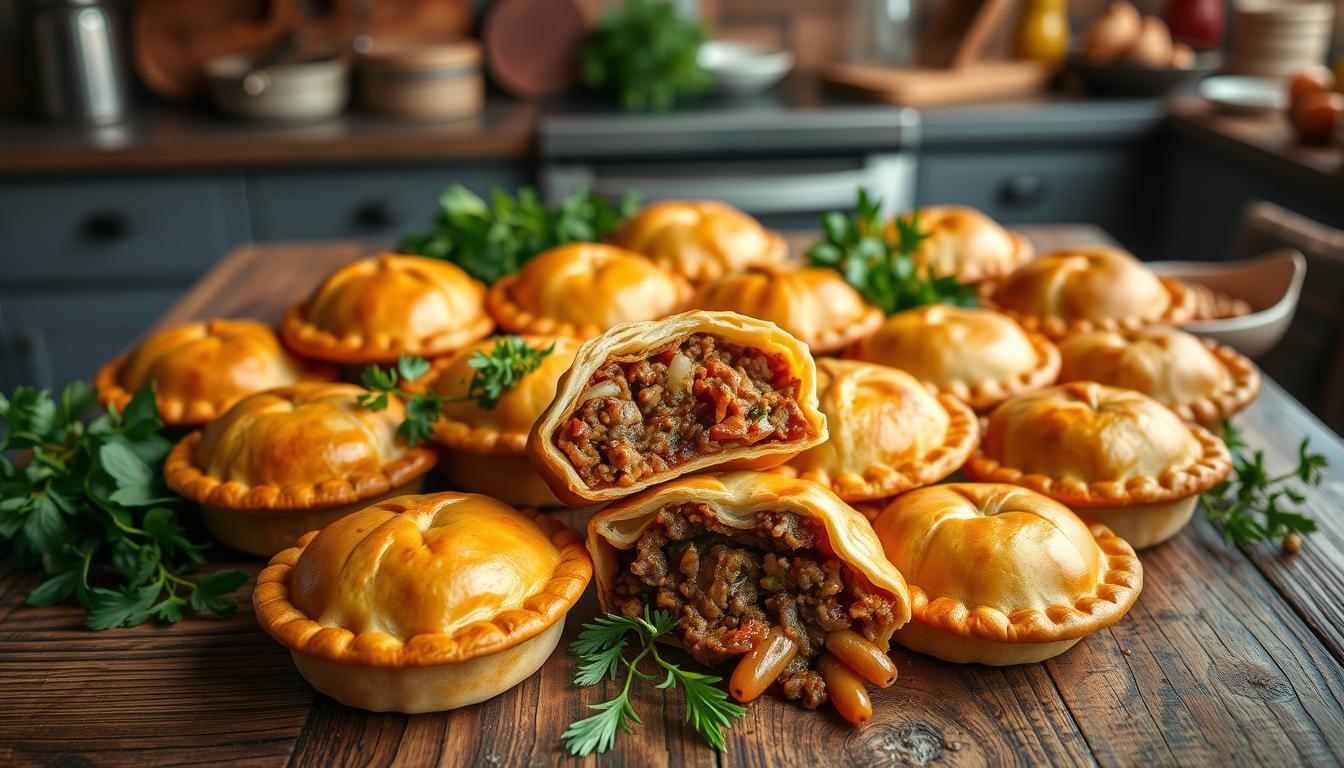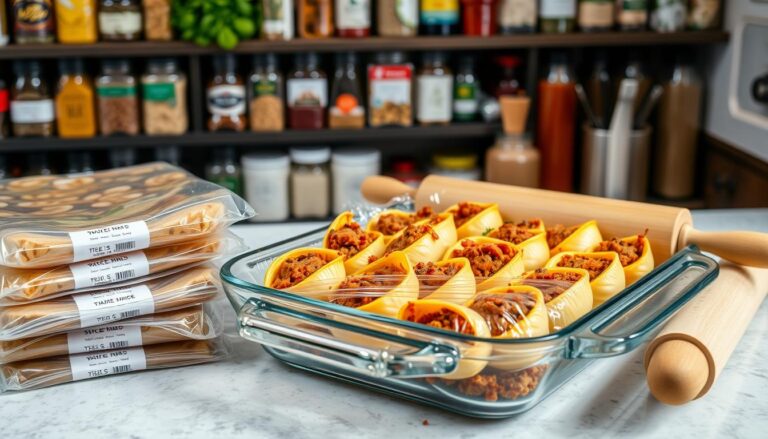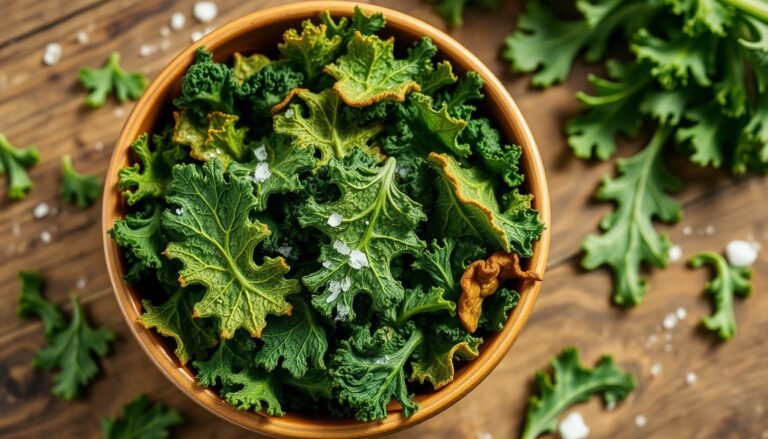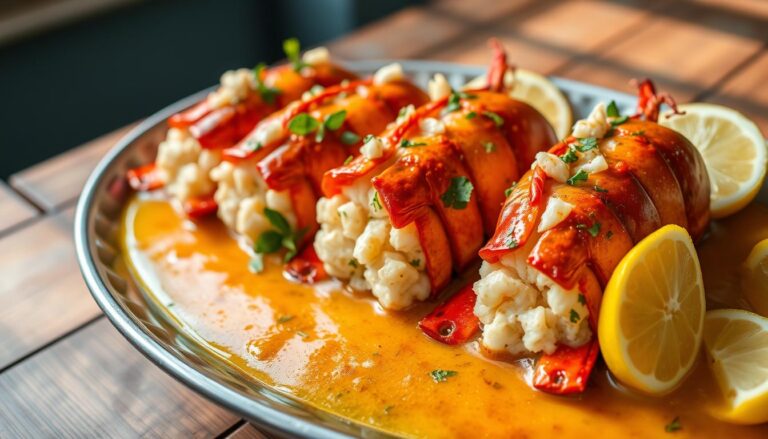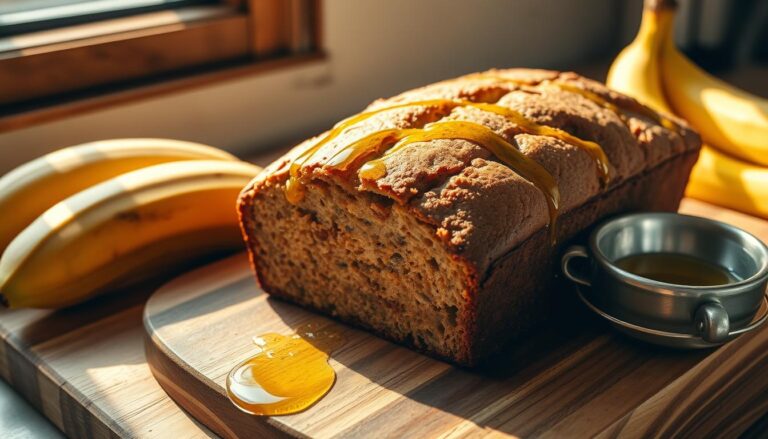intro
Nigerian Meat Pie Recipe is a savory pastry filled with spiced beef. The smell of the crust and the taste of the filling remind me of happy times with family.
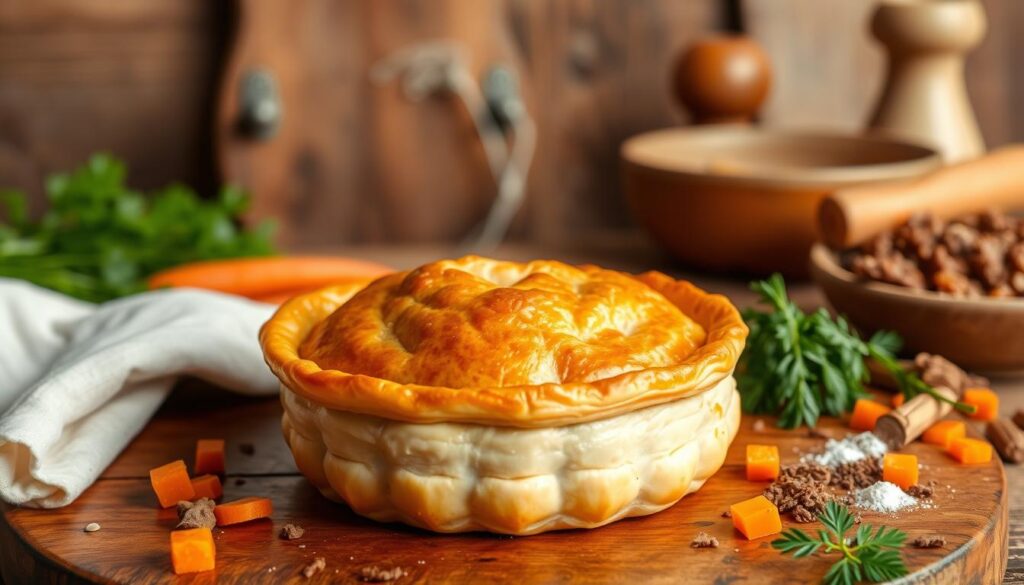
In this article, I’ll share how to make a real Nigerian meat pie. You’ll learn about its history, the ingredients, and how to make it. Whether you’re an experienced cook or new to African food, you’ll enjoy making and eating this pie. It’s a taste of Nigeria’s vibrant culture.
Table of Contents
Key Takeaways
- Nigerian meat pies are a beloved West African snack with a rich cultural history
- The recipe features a buttery, flaky pastry crust and a savory spiced beef filling
- Meat pies can be made in advance and stored for up to 5 days or frozen for up to 2 months
- Authentic Nigerian meat pies are often served at special events and celebrations
- The recipe includes a variety of aromatic spices and seasonings to create the distinct Nigerian flavor profile
The History and Cultural Significance of Nigerian Meat Pies
The Nigerian meat pie has a rich history. It started during the British colonization of Nigeria from 1884 to 1960. The Cornish pastry, brought by the British, evolved into the Nigerian meat pie we love today.
British Colonial Influence on Nigerian Cuisine
The British introduced the Cornish pastry to Nigeria. This pie, filled with beef and rutabaga, became a favorite. Nigerian cooks then added local spices and ingredients, making it uniquely African.
Evolution from Cornish Pastry to Nigerian Favorite
The Nigerian meat pie now has a ground beef filling with potatoes, onions, peas, and carrots. The crust is flaky and golden, thanks to flour, butter, sugar, and nutmeg. This mix of British and West African flavors has made it a favorite in Nigerian cuisine.
Role in Modern Nigerian Celebrations
Today, the Nigerian meat pie is a big part of Nigerian culture. It’s often served as “small chops” at celebrations. Alongside snacks like chin chin and dodo, it’s a hit at parties and weddings.
What Makes Nigerian Meat Pies Unique
Nigerian baked meat pies are special compared to other hand pies like empanadas. They have their own unique traits that make them a favorite party appetizer in Nigeria.
The dough used for Nigerian meat pies is a rough puff pastry. This pastry makes the crust flaky and buttery. The filling is usually ground beef, potatoes, and carrots, seasoned with Nigerian spices.
Nigerian meat pies are baked, not fried like empanadas. This baking method gives them a golden-brown look and a consistent taste. It also keeps the traditional flavor and texture that fans love.
| Attribute | Nigerian Meat Pies | Empanadas |
|---|---|---|
| Dough | Rough puff pastry | Variety of pastry doughs |
| Filling | Ground beef, potatoes, carrots, Nigerian spices | Wide range of fillings |
| Cooking Method | Baked | Fried |
| Flavor Profile | Consistent, traditional Nigerian taste | Varies based on filling |
The special dough, classic filling, and baking method make Nigerian meat pies unique. They are a beloved baked meat pie and hand pie in Nigerian cuisine and culture.
Essential Ingredients for Authentic Nigerian Meat Pie Recipe
Making the perfect Nigerian meat pie begins with the right ingredients. Whether you’re an experienced cook or new to baking, knowing the essential parts is key.
Pastry Dough Components
The Nigerian meat pie’s base is its flaky, golden pastry. It’s made from all-purpose flour, cold unsalted butter, and ice-cold water. A common mix is 4 cups of flour, 2 sticks of cold butter, and 1 cup of ice water.
Traditional Filling Ingredients
The filling is the heart of the Nigerian meat pie. It’s filled with ground meat fillings like beef or turkey. It also has diced potatoes, carrots, onions, and peppers. Seasonings like curry powder, nutmeg, thyme, and beef bouillon add flavor.
Seasonings and Spices
The authentic taste of a Nigerian meat pie recipe comes from the right seasonings. Besides curry powder and nutmeg, thyme, black pepper, and a bit of chili pepper enhance the flavor.
| Ingredient | Quantity |
|---|---|
| All-Purpose Flour | 4 cups |
| Unsalted Butter, cold | 2 sticks |
| Ice Water | 1 cup |
| Ground Beef | 1 pound |
| Potatoes, peeled and diced | 4 |
| Onion, sliced | 1 medium |
| Carrots, diced | 3 medium |
| Poblano Pepper, diced | 1 |
| Habanero Pepper, diced (optional) | 1 |
| Salt | 1 tsp |
| Beef Bouillon | 1 tsp |
| Curry Powder | 1/2 tsp |
| Dried Thyme | 1/2 tsp |
| Crushed Red Pepper Flakes | 1 tsp |
With these ingredients, you’re ready to make a delicious Nigerian meat pie. It will take you on a taste journey to Africa.
Tips for Creating the Perfect Flaky Pastry
Making a flaky, buttery crust is key for an authentic Nigerian meat pie. Your guests will love it. Here are some tips to help you make the perfect pastry:
- Use cold butter: Cold butter is essential for flakiness. Cut it into small pieces and chill it before using.
- Work quickly: The faster you work, the better. Overworking makes the crust tough. Handle the dough as little as possible.
- Chill the dough: Let the dough rest in the fridge for at least 30 minutes before rolling it out. This makes the crust flaky.
- Add a touch of sweetness: A small amount of sugar, about 1-2 tablespoons, enhances flavor and promotes browning in the flaky pastry.
- Experiment with spices: A pinch of nutmeg or a dash of cinnamon adds warmth and complexity to the Nigerian meat pie crust.
- Utilize a food processor: Pulsing the butter and flour together in a food processor creates a uniform texture. But don’t overprocess.
- Hand-mixing is also an option: If you don’t have a food processor, use a pastry blender or your fingers to mix the butter and flour.
By following these tips, you’ll make a flaky pastry that’s perfect for your Nigerian meat pie. Enjoy the delicious results of your hard work!
Step-by-Step Meat Filling Preparation
To make a real Nigerian meat pie, start with the filling. Cook 500 grams of ground meat fillings until it’s just right. Use a skillet over medium heat. Add diced onions, garlic, and spices like paprika and black pepper. Cook for 10-15 minutes, until the meat is browned and crumbled.
Then, add diced potatoes and carrots to the skillet. Cook until they’re tender, about 5-7 minutes. You can also add fresh or frozen peas for extra flavor and fiber. Use beef broth and cornstarch to thicken the filling. This makes it juicy and perfect for the pie.
Season the filling to your liking. Adjust the spices to get the right flavor. The filling should be tasty and match the pie’s crust. Let it cool completely before you start making the pies.
Cooking the Ground Beef Mixture
- In a skillet over medium heat, cook 500 grams of ground beef until browned and crumbled, about 10-15 minutes.
- Add diced onions, garlic, paprika, black pepper, and white pepper. Sauté until the onions are translucent, about 5 minutes.
Vegetable Preparation and Integration
- Dice 3 medium-sized potatoes and 2 carrots, then add them to the skillet with the ground beef mixture.
- Cook the vegetables until tender, about 5-7 minutes.
- For added fiber and flavor, you can also incorporate 1 cup of fresh or frozen peas.
Achieving the Ideal Filling Consistency
To thicken the filling and create a juicy, cohesive texture:
- Add 1 cup of beef broth to the skillet and bring the mixture to a simmer.
- In a small bowl, whisk together 2 tablespoons of cornstarch and 2 tablespoons of water to create a slurry.
- Slowly pour the cornstarch slurry into the simmering filling, stirring constantly until the desired thickness is achieved.
Taste the filling and adjust the seasoning as needed. Add more salt, pepper, or spices if you like. Let the filling cool completely before you start making the pies.
Assembling and Shaping Your Meat Pies
Making Nigerian meat pies is an art. The first step is to divide the dough into equal parts. Roll each part into a 1/4-inch thickness. Put the meat filling in the center, leaving space for sealing.
Use a large round biscuit cutter to make circles from the dough. This makes the edges look neat. Fold the dough over the filling and crimp the edges with a fork or your fingers.
- Divide the chilled dough into 6-8 equal portions.
- Roll each portion out to a 1/4-inch thickness.
- Place 2-3 tablespoons of the prepared meat filling in the center of the dough, leaving a 1/2-inch border.
- Fold the dough over the filling, forming a half-moon shape.
- Crimp the edges with a fork or your fingers to seal the Nigerian meat pies.
- For a more uniform look, use a 3-inch biscuit cutter to cut circles from the rolled-out dough.
- Brush the edges with beaten egg to further ensure a tight seal.
Working quickly and gently is key to making great hand pies. This keeps the pastry flaky and the filling inside. With practice, you’ll get better at making these tasty African pastries.

| Ingredient | Quantity |
|---|---|
| Chilled Dough | 6-8 portions |
| Meat Filling | 2-3 tablespoons per pie |
| Beaten Egg | For brushing |
| Biscuit Cutter (optional) | 3-inch diameter |
Baking Techniques for Golden-Brown Results
Getting the perfect golden-brown crust is key to a real Nigerian meat pie. To get your baked goods to look great and feel flaky, use these baking tips.
Temperature and Timing Guidelines
Heat your oven to 350-375°F (175-190°C). This temperature helps the crust brown evenly and cooks the filling well. Place your meat pies on a baking sheet covered with parchment paper to avoid sticking.
Bake the pies for 30-35 minutes. They should turn golden-brown. Check them often and rotate the sheet for even color.
Visual Cues for Perfect Doneness
Watch for visual signs to know when they’re done. The crust should turn golden-brown. Press the top gently; it should feel firm and flaky.
Brush the tops with a beaten egg before baking. This gives them a shiny look and a golden color.
By following these steps and watching for the right signs, you’ll make baked meat pies that are a treat. They’re perfect for any Nigerian cuisine event.
Storage and Reheating Methods
Whether you’ve baked a batch of delectable Nigerian meat pies or stocked up on some savory African snacks, proper storage and reheating techniques are key. These steps will help you enjoy their flaky perfection whenever you want.
Storing Baked Meat Pies
To store baked Nigerian meat pies, place them in an airtight container or wrap them tightly. Keep them in the refrigerator for up to 5 days. For longer-term storage, freeze the pies for up to 2 months.
To freeze, arrange the pies on a baking sheet and place them in the freezer for about 4 hours. Then, transfer them to a freezer-safe bag or container.
Reheating Refrigerated Meat Pies
When you’re ready to enjoy your refrigerated Nigerian meat pies, preheat your oven to 350°F (175°C). Place the pies on a baking sheet and warm them in the oven for 5-10 minutes. They should be heated through and the crust crispy.
Reheating Frozen Meat Pies
For frozen Nigerian meat pies, thaw them completely before reheating. You can thaw them in the refrigerator the night before. Once thawed, reheat the pies in the preheated 350°F (175°C) oven for 10-15 minutes.
By following these simple storage and reheating methods, you can enjoy the authentic flavors of Nigerian meat pies and other delectable African snacks long after they’ve been freshly baked.

Conclusion
The Nigerian meat pie is a delightful pastry that combines the country’s rich culinary heritage with global influences. This guide has shown you how to make authentic, flaky, and flavorful Nigerian meat pies at home. By following the steps for making the pastry dough, preparing the savory filling, and baking, you can enjoy this beloved African snack anytime.
The secret to a perfect Nigerian meat pie is the balance of the filling ingredients. Ground beef, potatoes, carrots, and seasoning cubes come together to create a seasoned and rich filling. Baking for 25-30 minutes gives the pastry a golden-brown crust and cooks the filling perfectly.
Don’t be afraid to try different spices or meats to make the pie your own. But remember, the essence of the classic savory pastries is what makes them special in Nigerian culture. These pies are great as a snack, appetizer, or even a main dish. They will surely delight your taste buds and take you on a journey to West Africa’s vibrant flavors.
FAQ
What is a Nigerian meat pie?
A Nigerian meat pie is a tasty West African snack. It has a spiced beef filling wrapped in a flaky pastry crust.
What is the origin of Nigerian meat pies?
Nigerian meat pies started during British rule (1884-1960). Cornish pastry was introduced then. Over time, it became a unique treat with ground beef and spices, different from traditional pastries.
How are Nigerian meat pies different from other hand pies?
Nigerian meat pies use a special rough puff pastry. They have a classic taste with little variation. The filling is ground beef, potatoes, and carrots, seasoned with Nigerian spices. Unlike empanadas, Nigerian pies are baked, keeping their flavor consistent.
What are the key ingredients in Nigerian meat pies?
The pastry is made with flour, cold butter, and ice water. The filling has ground beef, potatoes, carrots, onions, and garlic. It’s seasoned with curry powder, nutmeg, thyme, beef bouillon, and black pepper.
How do you achieve a flaky pastry for Nigerian meat pies?
To get a flaky pastry, use cold butter and work fast. Chill the dough for 30 minutes before rolling. Adding sugar and nutmeg to the dough can add extra flavor.
How do you prepare the meat filling?
Cook ground beef with onions, garlic, and spices. Add diced potatoes and carrots, cooking until they’re tender. Some recipes include peas for extra fiber. Use beef broth and a cornstarch slurry to thicken the filling.
How do you assemble and bake Nigerian meat pies?
Divide the dough into portions and roll out to 1/4 inch thickness. Place the filling in the center, leaving space around the edges. Seal the pies by folding the dough over and crimping. Brush with beaten egg and bake at 350-375°F for 30-35 minutes until golden.
How do you store and reheat Nigerian meat pies?
Store baked pies in an airtight container or wrap in the fridge for up to five days. Freeze for up to two months for longer storage. To reheat, bake at 350°F for 5-10 minutes or microwave briefly. Thaw frozen pies before reheating.
for more recipes
diverse recipes – not only sweet recipes

